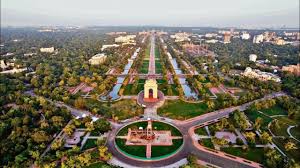
Central Vista Makeover
Central Vista Makeover Stirs National Debate on Heritage, Costs, and Governance
The Central Vista redevelopment project in New Delhi is one of the most ambitious infrastructure undertakings in India’s recent history. Located at the heart of the nation’s capital, the Central Vista is not only a political and administrative hub but also a symbolic space representing India’s democratic heritage.
As construction progresses, the project has sparked discussions across the country. Supporters hail it as a necessary modernization of outdated infrastructure, while critics raise concerns over costs, timing, and the potential loss of architectural heritage.

This article provides a comprehensive analysis of the Central Vista makeover, including its background, scope, political controversies, public reception, global comparisons, and long-term implications.
Background: The Legacy of Central Vista
The Central Vista, designed by British architects Sir Edwin Lutyens and Herbert Baker in the early 20th century, forms the power corridor of India. Stretching from Rashtrapati Bhavan to India Gate, it houses key government buildings including:
- The Parliament House
- North and South Block (housing Ministries of Defence, Finance, and Home)
- Central Secretariat offices
While iconic, these buildings have struggled to keep up with modern needs. Overcrowding, outdated facilities, and rising maintenance costs made a strong case for redevelopment.
The Makeover Plan
The government announced the Central Vista redevelopment in 2019 with the following objectives:
- New Parliament Building – A triangular structure with modern technology, increased seating capacity, and earthquake-resistant features.
- Central Secretariat Buildings – Consolidation of scattered ministries into modern, energy-efficient offices.
- Common Central Vista Avenue – Redesigned green spaces, public pathways, and cultural amenities for citizens.
- Prime Minister’s and Vice President’s Residences – Relocated official housing within the complex.
The vision was to create a functional, futuristic, and sustainable power center, while preserving India’s democratic symbolism.
Cost and Funding Debate
The project’s estimated cost has been a central point of debate. Originally pegged at ₹20,000 crore (approx. $2.5 billion), critics argue the expenditure is excessive, especially in the aftermath of the COVID-19 pandemic.
Supporters counter that:
- Cost efficiencies will come from centralizing government offices.
- Maintenance savings on old, dilapidated structures will offset the expense.
- Long-term vision justifies upfront investment.
Still, the perception of lavish spending during economic hardship remains contentious.
Political and Public Reaction
Supporters’ View:
- The new Parliament is seen as a symbol of New India, reflecting confidence, functionality, and inclusivity.
- Improved facilities are expected to enhance governance efficiency.
- Advocates also argue the project is about nation-building and projecting India’s rising global stature.
Critics’ Concerns:
- Timing of the project amid a health and economic crisis.
- Risk of erasing Lutyens’ architectural heritage.
- Questions of transparency in awarding contracts.
- Environmental concerns about tree felling and ecological disruption.
The Central Vista has thus become a political flashpoint, with narratives of pride clashing with concerns over priorities.
Heritage and Conservation Debate
The Central Vista is more than infrastructure; it is a heritage site that embodies India’s democratic identity. Critics worry that:
- Modern buildings may overshadow the historic character of Lutyens’ Delhi.
- Lack of adequate heritage consultation risks cultural loss.
However, officials argue the redevelopment carefully blends old and new, retaining Rashtrapati Bhavan, India Gate, and parts of the original layout.
Environmental and Urban Planning Angle
Delhi, already struggling with air pollution and shrinking green spaces, faces scrutiny over the environmental impact of the makeover. While the government has promised green-certified construction and sustainable practices, environmentalists remain cautious.
The project also highlights the tension between urban modernization and ecological preservation in rapidly growing capitals worldwide.
Global Comparisons
Many nations have modernized their parliamentary complexes:
- United States – The Capitol has undergone continuous expansion while preserving heritage.
- UK – Parliament is undergoing a multibillion-pound restoration.
- Brazil – The National Congress in Brasília reflects futuristic architecture built in the mid-20th century.
India’s Central Vista project fits into this global pattern of upgrading governance infrastructure, though each case raises similar debates on heritage and costs.
Expert Opinions
Architectural Expert, Meera Krishnan:
“Urban design is about balancing heritage with functionality. The Central Vista can succeed if it respects India’s past while embracing its future.”
Political Analyst, Arvind Nair:
“For the public, the debate is not just about buildings but about trust. Transparency and accountability will decide how this project is remembered.”
Future Implications
The Central Vista makeover has far-reaching consequences:
- Symbolic – It could redefine India’s national identity for generations.
- Administrative – Consolidated offices may improve efficiency and coordination.
- Political – The project will be judged in the court of public opinion for years to come.
Its success depends not only on architectural execution but also on how well it resonates with citizens.
Conclusion
The Central Vista makeover is more than an architectural project; it is a test of governance, vision, and accountability. While the new infrastructure promises modernization, efficiency, and a bold statement of India’s aspirations, it also raises questions about heritage, costs, and priorities.
As the project nears completion, the Central Vista will continue to stir debates that go far beyond bricks and mortar. It reflects India’s ongoing struggle to balance tradition and modernity, governance and accountability, pride and prudence.




